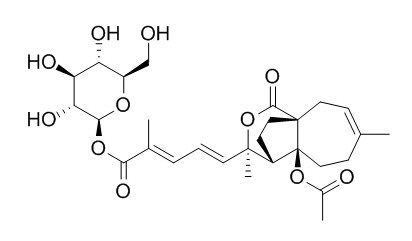Pseudolaric acid A-O-beta-D-glucopyranoside
Inquire / Order:
manager@chemfaces.com
Technical Inquiries:
service@chemfaces.com
Tel:
+86-27-84237783
Fax:
+86-27-84254680
Address:
1 Building, No. 83, CheCheng Rd., Wuhan Economic and Technological Development Zone, Wuhan, Hubei 430056, PRC
Providing storage is as stated on the product vial and the vial is kept tightly sealed, the product can be stored for up to
24 months(2-8C).
Wherever possible, you should prepare and use solutions on the same day. However, if you need to make up stock solutions in advance, we recommend that you store the solution as aliquots in tightly sealed vials at -20C. Generally, these will be useable for up to two weeks. Before use, and prior to opening the vial we recommend that you allow your product to equilibrate to room temperature for at least 1 hour.
Need more advice on solubility, usage and handling? Please email to: service@chemfaces.com
The packaging of the product may have turned upside down during transportation, resulting in the natural compounds adhering to the neck or cap of the vial. take the vial out of its packaging and gently shake to let the compounds fall to the bottom of the vial. for liquid products, centrifuge at 200-500 RPM to gather the liquid at the bottom of the vial. try to avoid loss or contamination during handling.
Drug Des Devel Ther.2020, 14:969-976.
Molecules.2019, 24(6):E1155
Environ Toxicol.2023, 38(5):1174-1184.
Phytomedicine.2023, 117:154929.
Int J Mol Sci.2023, 24(8):7300.
Korean J of Pharmacognosy2020, 51,49-54.
Sci Rep.2017, 7:467-479
Proc Biol Sci.2024, 291(2015):20232578.
Food Addit Contam Part A Chem Anal Control Expo Risk Assess.2020, 37(9):1437-1448.
Pest Manag Sci.2019, 75(9):2530-2541
Related and Featured Products
J Pharm Biomed Anal. 2007 Jul 27;44(3):730-6.
Simultaneous determination of seven major diterpenoids in Pseudolarix kaempferi by high-performance liquid chromatography DAD method.[Pubmed:
17446030 ]
METHODS AND RESULTS:
A reversed phase high-performance liquid chromatography method was established for the first time to simultaneously qualify the seven major diterpenoids in Pseudolarix kaempferi, namely pseudolaric acid B O-beta-D-glucopyranoside (1), pseudolaric acid C2 (2), pseudolaric acid C1 (3), deacetylpseudolaric acid A (4), Pseudolaric acid A-O-beta-D-glucopyranoside (5), pseudolaric acid B (6) and pseudolaric acid A (7). The optimal conditions of separation and detection were achieved on an Inertsil ODS-3 column with gradient elution of methanol and 0.5% aqueous acetic acid (v/v) at the flow rate of 0.6 ml min(-1) within 40 min and detection wavelength set at 262 nm. All calibration curves showed good linear regression (r2>0.9999) within test ranges. This method provided good accuracy with recoveries in the range of 94.3-106.1% and good precision with R.S.D.s of repeatability and intermediate precision less than 0.57% and 4.67%, respectively. The method was successfully applied to qualitative and quantitative determination of 20 P. kaempferi among the 54 samples collected from different areas.
CONCLUSIONS:
The results revealed that the commercial crude drugs were seriously confused and the developed HPLC assay could be used as a suitable qualitative and quantitative determination method for P. kaempferi.
Yao Xue Xue Bao. 2014 Aug;49(8):1169-74.
Metabolic pathway and metabolites of total diterpene acid isolated from Pseudolarix kaempferi.[Pubmed:
25322560]
The preliminary metabolic profile of total diterpene acid (TDA) isolated from Pseudolarix kaempferi was investigated by using in vivo and in vitro tests.
METHODS AND RESULTS:
Pseudolaric acid C2 (PC2) was identified as the predominant metabolite in plasma, urine, bile and feces after both oral and intravenous administrations to rats using HPLC-UV and HPLC-ESI/MS(n), and demethoxydeacetoxypseudolaric acid B (DDPB), a metabolite proposed to be the glucoside of PC2 (PC2G), as well as pseudolaric acid C (PC), pseudolaric acid A (PA), Pseudolaric acid A-O-beta-D-glucopyranoside (PAG), pseudolaric acid B O-beta-D glucopyranoside (PBG) and deacetylpseudolaric acid A (DPA) originated from TDA could also be detected. It was demonstrated by tests that the metabolism of TDA is independent of intestinal microflora, and neither of pepsin and trypsin is in charge of metabolism of TDA, TDA is also stable in both pH environments of gastric tract and intestinal tract. The metabolites of TDA in whole blood in vitro incubation were found to be PC2, DDPB and PC2G, which demonstrated that the metabolic reaction of TDA in vivo is mainly occurred in blood and contributed to be the hydrolysis of plasma esterase to ester bond, as well as the glucosylation reaction.
CONCLUSIONS:
These results clarified the metabolic pathway of TDA for the first time, which is of great significance to the in vivo active form and acting mechanism research of P. kaempferi.



